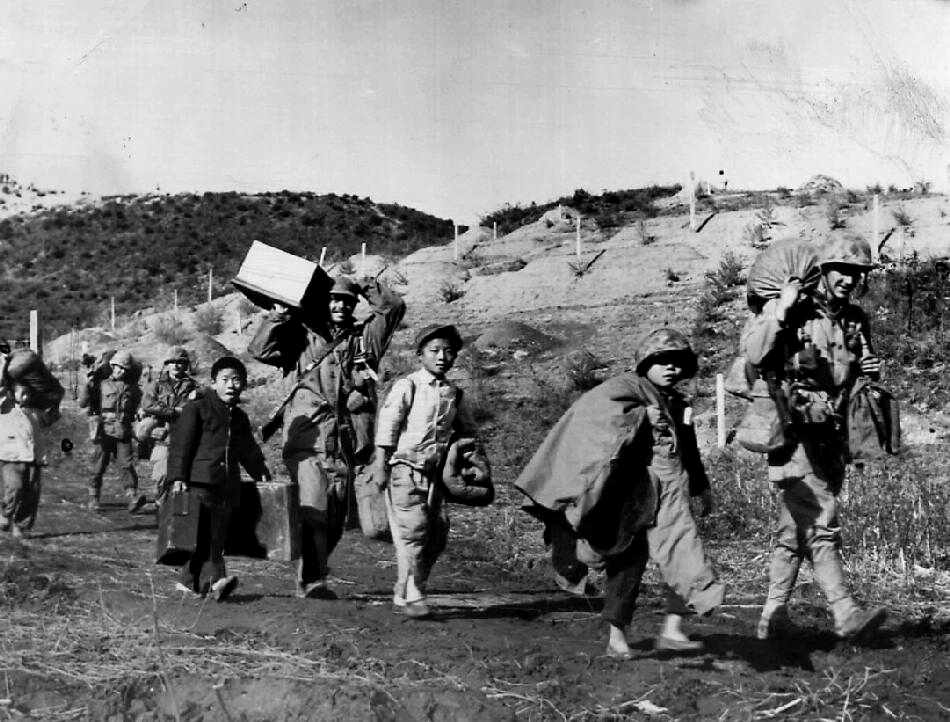
The Korean War: United Nations Drive North (October-November 1950)

Figure 1.--Here Korean boys are assisting the Marines that had landed at Wonson. The press caption optimistically read, "Youthful 'red caps on Korean friont: Youthful Korean lads, greatful to the United Nation's troops for good food and clothing, take up chores as volunteer 'red caps' as they carry extra gear for the Marines units in mopping-up operations near Wonsan. These mop-up operations are cleaning out the Reds who are hiding in caves in outlying areas. Today's report from the fighting front reveal that the United Nation's troops, fighting in bittet sub-zero weather, have advanced up to ten miles without meeting organized Communisdt resistance, in their drive toward the Manchurian border." The photograsph was taken at Wonsan, November 19, 1950. Photo source: U.S. Army.
|
|
MacArthur rushed the United Nations forces north accross th 38th parallel to completely defeat and occupy North Korea. Tuman was skeptical, but MacArthur assured him that Chinese warnings to intervene were bluff. U.N. forces began crossing the 38th Parallel (October 1). ROK forces crossed first. MacArthur demanded the North Lorean Army's unconditional surrender. When no reply was received. the American and other U.N. forces plunged into the North (October 7). The cmet only disorganized North Korean resistance. The North Korean capital of Pyongyang fell (October 19). The 8th Army, under Gen. Walton Walker, and the X Corp, under Gen. Edward Almond, drove the North Koreans north. The Inchon landings had proven so sucessful that General MacArthur decided on another landing, this time along the eastern coast. He chosen Wonson above the 38th parallel in southeastern North Korea. The plan was for X Corp to land there and link up with the Eighth Army moving north from Seoul. MacArthur hoped to cath what remained up the North Korean Army and destroy it.
Wonsan would also provide a useful sea pott and logistical base for the push north to the Yalu. Wonson was one of the best ports in Korea, It had a substantil handling capacity and none of the tidal complivations that limited the use of Inchon. The North Korean Arny collapsed faster than anticipted by the U.N. Command. And by the anticipated landing date (October 20), the 8th Army has already arrived. X Corp landed anyway and supported the push north. And the U.S. Navy began landing needed supplies. North Korean mines caused some problems and caused the Navy to reassess its minesweepers and anti-mine capability. There were also landings at Riwon further north which ROK forces had already taken.
The 187th Airborne Regimental Combat Team ("Rakkasans") executed the first of the only two combat jumps during the War at Sunchon and Sukchon (October 20). The objective was cut the road north to China and prevent North Korean leaders from escaping Pyongyang. They also wanted to rescue American POWs. The United Natiin by the end of October had taken 135,000 KPA North Koreans as POWs. The 8th Army pushed north, almost to the Yalu River (November 24). The Yalu was the border between China and Korea. The new Chinese Communist Government had made it clear that they would not tolerate the United States on their border. General MacArthur dismissed the warnings as a bluff.
CIH

Navigate the Children in History Website:
[Return to Main Korean War page]
[Return to Main specific war and crisis page]
[Return to Main early Cold War period page]
[Return to Main Korean history page]
[Introduction]
[Animals]
[Biographies]
[Chronology]
[Climatology]
[Clothing]
[Disease and Health]
[Economics]
[Geography]
[History]
[Human Nature]
[Law]
[Nationalism]
[Presidents]
[Religion]
[Royalty]
[Science]
[Social Class]
[Bibliographies]
[Contributions]
[FAQs]
[Glossaries]
[Images]
[Links]
[Registration]
[Tools]
[Children in History Home]
Created: 2:18 AM 12/23/2011
Last updated: 2:18 AM 12/23/2011



